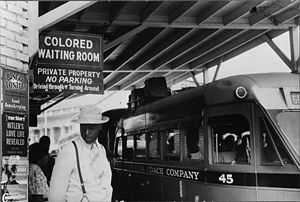Jack Delano
| Jack Delano | |
|---|---|
 Jack Delano in his studio. Trujillo Alto, Puerto Rico, 1990 | |
| Born |
Jacob Ovcharov August 1, 1914 Podolie Governorate, Russian Empire |
| Died |
August 12, 1997 (aged 83) Puerto Rico, United States[1] |
| Nationality | American |
| Occupation | photographer for the Farm Security Administration |
Jack Delano (August 1, 1914 – August 12, 1997) was an American photographer for the Farm Security Administration (FSA) and a composer noted for his use of Puerto Rican folk material.
Biography
Delano was born as Jacob Ovcharov (Cyrillic: Яков Овчаров) in Voroshilovka village, Podolie Governorate, near Vinnytsia, Russian Empire and moved, with his parents and younger brother, to the United States in 1923. The family arrived at New York on July 5, 1923 on the boat SS Homeric. Between 1924 and 1932 he studied graphic arts/photography and music (viola and composition)[2] at the Settlement Music School and solfeggio with a professor from the Curtis Institute in Philadelphia, Pennsylvania.[3] After being awarded an art scholarship for his talents, he attended the Pennsylvania Academy of the Fine Arts (PAFA) where, from 1928 until 1932, he studied illustration and continued his musical training. While there, Delano was awarded the Cresson Traveling Scholarship, on which he chose to travel to Europe, where he bought a camera that got him interested in photography.


After graduating from the PAFA, Delano proposed a photographic project to the Federal Art Project: a study of mining conditions in the Schuylkill County, Pennsylvania anthracite coal area. Delano sent sample pictures to Roy Stryker and applied for a job at the Farm Security Administration Photography program FSA. Through the help of Edwin Rosskam and Marion Post Wolcott, Stryker offered Delano a job at $2,300/year. As a condition of the job, Delano had to have his own car and driver's license, both of which he acquired before moving to Washington, D.C.
Before working at the FSA, Delano had done his own processing and developing but did neither at the FSA. Other photographers working for the FSA include Walker Evans, Dorothea Lange, and Gordon Parks. In 1943 FSA was eliminated as "budget waste" and subsumed into the Office of War Information (OWI).


He travelled to Puerto Rico in 1941 as a part of the FSA project. This trip had such a profound influence on him that he settled there permanently in 1946.
With his wife Irene (a second cousin to fellow photographer Ben Shahn) he worked in the Community Division of the Department of Public Education producing films, for many of which Delano composed the score.[4] Delano also directed Los Peloteros, a Puerto Rican film about poor rural kids and their love for baseball. The film remains a classic in Puerto Rican cinema.
Jack Delano's musical compositions included works of every type: orchestral (many composed for the Puerto Rico Symphony Orchestra), ballets (composed for Ballet Infantil de Gilda Navarra and Ballets de San Juan), chamber, choral (including Pétalo de rosa, a commission for Coro de Niños de San Juan) and solo vocal. His vocal music often showcases Puerto Rican poetry, especially the words of friend and collaborator Tomás Blanco. Blanco, Délano and his wife Irene collaborated on children's books. The most prominent of these remains a classic in Puerto Rican literature: The Child's Gift: A Twelfth Night Tale by Tomás Blanco, with illustrations by Irene Delano and incidental music (written on the margins) by Jack Delano.
His score for the film "Desde las nubes" demonstrates an early use of electronic techniques. Most of his works composed after he moved to Puerto Rico are notable for using folk material in a classical form.[5]
Selected compositions
- Orchestral
- Ofrenda Musical (Musical Offering) for viola, horn and string orchestra (1959)
- El sabio Doctor Mambú, Ballet for children (1962); libretto by the composer
- Concertino classico for C trumpet and small orchestra (1968)
- Sinfonietta for string orchestra (1983)
- Chamber and instrumental music
- Sonata in A minor for viola and piano (1953)
- Sonata for violin solo (1960)
- Sonatina for flute and piano (1965)
- String Quartet (1984)
- Tres preludios (3 Preludes) for piano (1985)
- Vocal
- Esta luna es mía for soprano solo, female chorus and piano (1962); words by José P.H. Hernández
- Me voy a Ponce for mixed chorus (1965); words by José Agustín Balseiro
- Tres cancioncitas del mar for medium voice and piano (1969); words by Nimia Vicéns, Ester Feliciano Mendoza and Carmelina Vizcarrondo
- Cuatro sones de la tierra for soprano and piano (1974); words by Tomás Blanco
- Pétalo de rosa, Suite for a cappella children's choir (1993); written for the San Juan Children's Choir
- Film scores
- Los Peloteros (1953)
Gallery
-

"At the bus station." May 1940.
-

"Children in Utuado, Puerto Rico". May 1942
-

"Washing eggs to be sold at Tri-County Farmers Co-op Market at Du Bois, Pennsylvania"
References
Bibliography
- H. Wiley Hitchcock and Stanley Sadie (eds), New Grove Dictionary of American Music, (London: Macmillan Press, 1986), volume 1, p 595.
- Composers of the Americas: biographical data and catalogs of their works, (Washington: Secretaría General, Organización de los Estados Americanos), volume 19, pp 22–27.
External links
| Wikimedia Commons has media related to Jack Delano. |
- Interview of Jack & Irene Delano by Richard Doud of the Archives of American Art, Smithsonian Institution (June 12, 1965)
- Photography of Jack Delano
- Bound for Glory, exhibit featuring color photographs by Delano and others.
- Handpicked selection of photographs at Shorpy
- Columbus Museum of Art Web page on Delano's 1940 photograph Miner at Dougherty's Mine, Near Falls Creek, Pennsylvania (click on picture for larger image)
- Portrait of an Artist: Jack Délano by Francisco J. Cabán-Vales, Musiké
- Jack Delano at Find a Grave
|